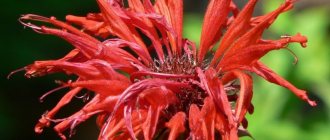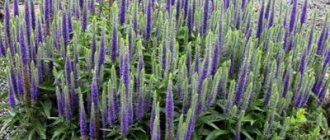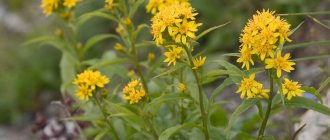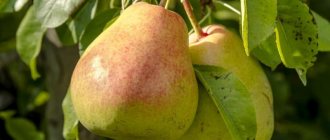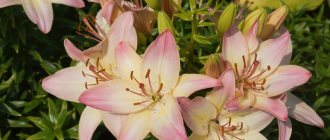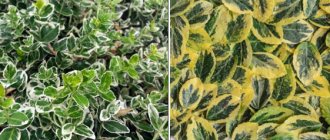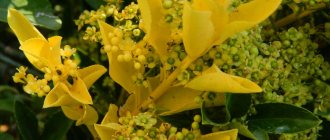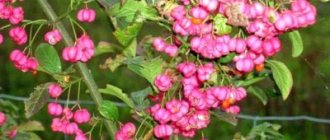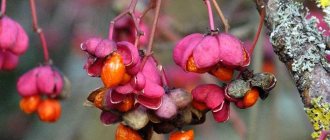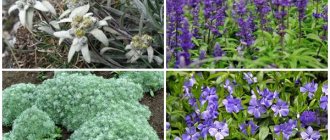Botanical description of the species
Fortune's euonymus (lat. Euonymus fortunei) is a creeping evergreen low-growing shrub native to China. The name is due to the name of the scientist R. Fortune, who was the first to give it a botanical description. The plant reaches a height of 0.5 m, and can stretch up to 2-3 m in length. Creeping shoots form nodes from which new roots grow, which allows the bush to entwine supports and grow in this way.
The leaves are most often two-colored, they are dense and grow very close to one another, creating a dense crown. The length of the leaf can reach up to 5-6 cm. In the central part of Russia and in the middle zone, euonymus does not bloom.
In autumn, the shrub produces fruits, which are often poisonous. The varieties bred by breeders rarely bear fruit. In its natural environment, euonymus blooms have an inconspicuous olive color. Inflorescences are formed only in the southern regions; we can say that in Russia the euonymus does not have time to mature to the point of toxicity. The shrub grows quite normally in most of Eurasia, withstanding frosts down to -25°C.
It has a lot of wonderful properties, thanks to which it has gained popularity among gardeners:
- evergreen perennial;
- The shrub does not grow quickly, so it does not require pruning;
- does not require daily care;
- has high winter hardiness;
- can curl along a support;
- there is no need to replant every year;
- goes well with most other species, especially conifers.
Did you know? From Latin name
“
Euonymus
”
is translated as “Alluring with beauty.”
Types and varieties
The euonymus fortunena plant and its species are used as ground cover and as vertical gardening. There are more than 200 species and varieties of shrubs. The most famous and popular:
- Emerald Gaiety . Frost-resistant ground cover bush reaches 25 cm in height. The leaves are dark green with a white border.
- harlequin . A dwarf ground-blooded shrub that is shade-loving and susceptible to frost. White interspersed with yellow and pink flowers.
- Esmerald Gold . Used for vertical gardening. Emerald gold color. Frost-resistant and sun-loving species. Reaches 200 cm in height.
The use of Fortune's euonymus in landscape design
Thanks to the above qualities and original appearance, Fortune's euonymus has gained popularity among gardeners and landscape decorators.
Here are just some of the elements and compositions where it has found its application:
- imitation lawns;
- hedge;
- growing on a support, pergola, walls of gazebos;
- accenting borders;
- an element surrounding the central tall figure of the composition;
- alpine slide;
- Japanese and heather gardens;
- foreground of deep composition, etc.
Pairs perfectly with conifers of any height. Looks great as one of the plants surrounding a tall coniferous tree. Looks good on sand and stones, looks harmonious with flowers of yellow, white and various bright shades (irises, tulips, etc.). Perfect for creating beautiful living walls on a pergola, simulating natural vegetation, such as a clearing.
A valuable ornamental plant for landscape designers
Fortune's euonymus in landscape design, photos of which help make the site original and stylish, is especially popular among gardeners. This plant is often one of the central elements of any original composition.
Low-growing varieties are used as the main element in the design of borders, paths, lawns and hedges.
The culture is also actively used to create the perimeter of flower beds or rock gardens.
A special type of groundcover euonymus can occupy the entire area of the lawn, so its appearance can enliven the monotonous construction of a garden landscape.
Tall varieties are usually placed in the center of the composition, while the plant requires enhanced care in the form of regular crown formation.
Fortune's euonymus in an alpine hill or rock garden is in excellent company with deciduous perennials and flowering phlox. Low-growing junipers will emphasize the brightness and decorativeness of the leaves of the evergreen shrub in the rock garden.
Looks very nice in composition with coniferous crops. Emerald foliage with a golden border accentuates the shade of the pine needles, and makes the plant an unrivaled decorative element on the site.
By planting Fortune's euonymus in the right place, you can transform your local area into a life-giving corner that delights its creator. You can't help but fall in love with this graceful plant. The beautiful colors of the leaves, which delight the whole season, completely pay for the gardener’s troubles and concerns.
Popular varieties
Below is a description of the most popular varieties of Fortune's euonymus. The plants that will be discussed, in addition to external data, have such an important quality as frost resistance, which is important in Russian conditions.
Sunspot
Euonymus Sunspot (Sunny Bunny) - height does not exceed 25 cm, shoot length reaches 1.2 m. Dense small foliage creates a lush and voluminous spherical crown. Compared to other varieties of the species, it grows quickly, adding up to 30 cm annually. Feels great both in the sun and in the shade, and tolerates frost well.
The length of the green leaves, interspersed with lemon color in the middle, does not exceed 25 mm. Sunny bunny is grown in Siberia and the Far East, where it is used to frame tall plants to create the foreground of voluminous plantings. Found application in the decoration of fountains, rock gardens, Japanese and heather gardens. Thanks to its fast growth, it is good for growing on posts, walls and pergolas.
Emerald Haiti
Emerald gaiety (Emerald Joy) is a popular variety, perfect for growing in temperate latitudes. The reason for this is that the variety is the most winter-hardy of all representatives of the species. Grows normally in the shade; It doesn’t shed the green mass for the winter, it just changes its color.
The maximum height to which Emerald Joy grows is no more than 30 cm, but the shoots are distinguished by abundant dense foliage, forming a wide-spread crown. The variety has an exclusively decorative appearance. Elliptical leaves up to 6 cm long have an emerald color (as reflected in the name) with a white border. With the onset of winter, the color changes to pink.
The stems are flexible and take root well when in contact with the soil. Emerald Haiti goes well with various flowers, especially yellow and white (tulips, cockerels, lilies, etc.). Suitable for decorating borders, filling empty space in flower beds, for soil cover, planting on slopes and edges of ridges.
Blondie
It can reach a height of 30–55 cm. The shoots, upon contact with the soil, quickly take root, grow and form a continuous carpet. If there is a tree trunk or some kind of stand nearby, Blondie climbs onto it. This quality is used by landscape designers to create a beautiful vertical covering of walls or other surfaces.
The leaves are oval-shaped, arranged oppositely, shiny, green, with a yellow spot in the center. Length - up to 4 cm, width - up to 2.7 cm. Blondie can grow in places well lit by the sun and in the shade. Absolutely unpretentious, gets along on all types of soil with any level of acidity. The location of the roots is superficial. The variety can be used in almost any composition: as a tapeworm, ground cover plant (horizontal and vertical), or as an element surrounding the central plant.
Emerald Gold
Emerald Gold or Golden Emerald is a plant up to 40 cm high, it is used as an element of vertical gardening. Sort has a long growing season, which can reach up to 5 years. It is well adapted to winters, typical for most of Russia, and tolerates frosts down to -23°C.
Did you know? obtained from
the euonymus, which is called fusin, is used in painting, as it not only leaves clear marks, but also erases without a trace.
Emerald Gold loves well-lit places; growth slows down in the shade. It has pointed oval leaves of medium size, hard, with a glossy surface. The color is two-tone: the main one is lemon, in the middle there is an olive-colored spot. By September, the color becomes burgundy, evenly covering the entire leaf blade, without any inclusions of another color. The branches are quite elastic and rigid, abundantly leafy. In the southern regions it blooms with small greenish flowers, after which it bears fruit with scarlet burgundy berries.
Silver Queen
Silver Queen is a creeping shrub that is most suitable for a vine-forming plant. It stands out among other varieties for its height - it can reach 70 cm, the shoot grows to almost 45 cm in a season. The variety is unpretentious, grows well in the sun and in the shade. Tolerates low temperatures, drought and other adverse weather conditions.
The queen does not shed green mass. It has elongated leaves bordered by a light stripe. The surface of the plate is glossy, elastic, intense emerald color. The stems are purple, strong and flexible, the crown is thick and lush, turning burgundy in autumn. Silver Queen does not bloom or bear fruit. It grows well on a stand or trellis, and is used as a hedge, in the design of bosquets and ponds.
Minimus
As the name suggests, this is the smallest of all varieties. It is an evergreen, slow-growing, creeping plant, the accumulation of which looks like a living carpet. The height usually does not exceed 20 cm, and the width - 50 cm.
The arrangement of the leaves is opposite, they are round or elliptical, usually no more than 7 mm in length, although sometimes they grow 2 times larger. The width of the oval-shaped leaves ranges from 5 to 8 mm. The surface is leathery, matte, emerald green with light veins.
Does not tolerate excessive moisture, winters normally at temperatures down to -25°C. Minimus is an ideal option for creating an imitation of a natural green meadow: when planting 5 bushes per 1 m², in the third season you will get a solid emerald carpet with beautiful miniature leaves.
Fortune's euonymus, its biological characteristics and features
Euonymus is a low woody plant with tetrahedral or rounded shoots.
Its height varies from 5 to 15 m. The plant is decorated with smooth glossy leaves, which are located oppositely on the stem. Regardless of the time of year, they have a dark green tint. The bush is characterized by an attractive mosaic crown, which is especially noticeable when exposed to direct light. Racemose inflorescences consist of small, inconspicuous flowers of pale green or brown color. The fruits are dry capsules containing 4 compartments equipped with spines or lionfish. Inside are seeds covered with fleshy tissue. They have different shades in different species.
Planting in open ground
Fortune's euonymus is planted similarly to most shrub plants of other species. If you have planted fruit bushes, lilacs or hydrangeas at least once, the procedure should not cause you any difficulties.
Deadlines
Planting is carried out in autumn or spring . In the middle zone, you should not delay the procedure, as the euonymus will not have time to take root. Despite the fact that many varieties have fairly high winter hardiness, a young plant may suffer from frost if it fails to take root before it occurs.
If you are late with the autumn procedure, plant the plant in a pot and transfer it to open ground in the spring. In Russian conditions, the most suitable timing for the procedure is approximately the second ten days of April or the first half of May.
Important! If you plant shrubs in the fall, you need to organize additional protection from the wind. In this case, it is better to give preference to a place under a tree or against a wall.
Selecting a seedling and planting site
It is more advisable to purchase seedlings in specialized stores. Retail outlets selling products and plants for landscape design usually offer a wide selection of various varieties of this species. In addition, you can use shrubs already growing on the site and obtain planting material from it, which will be discussed in detail below.
When purchasing a seedling, pay attention to the following external signs:
- the shoot and roots must be strong, without visible damage;
- the bark is healthy, without spots or inclusions of a different color;
- the entire seedling, including the root system, must contain sufficient moisture; signs of dryness or increased fragility are unacceptable.
The landing site must be selected in such a way that it meets the following conditions:
- open space well lit by sunlight;
- It is desirable that it be a hill or slope, since the plant does not tolerate excess moisture at the roots.
Ideally, you need to find a place where the intensity of the sun's rays is low during the daytime, preferably light shading at midday. The fact is that bright light can cause foliage to wilt slightly, which does not give the plant decorative qualities.
Soil preparation
Fortune's euonymus is quite undemanding in terms of soil composition, although for planting you will need to prepare a substrate from equal parts of peat, humus and turf soil. For each bucket of this mixture, add 2 liters of wood ash and mix everything thoroughly.
Landing algorithm
Planting shrubs is quite simple. No special knowledge or skills are required for this; the procedure is as follows:
- A planting hole should be dug in the selected area. The size of the hole should be such that there is a space of 10–13 cm between the roots of the seedling freely spread in it and the walls. Although the location of the roots is superficial, when digging a hole, you should take into account the thickness of the drainage and the substrate poured on it, on which the seedling will be located. That is, add another 25–30 cm to the required depth of the hole.
- At the bottom you need to place a drainage (15 cm thick), consisting of crushed stone, sand, crushed brick, etc. Place a layer of prepared substrate (10–15 cm) on top.
- Place the seedling on an earthen embankment, straighten its roots, and cover it with fertile substrate.
- Within a radius of 30–35 cm from the seedling, build a shaft delimiting the trunk circle. Moisten the bush with a bucket of warm water and mulch the soil with pine needles, peat or pine sawdust, or a mixture of them.
Most varieties of Fortune's euonymus are light-loving. Even if they can grow in the shade, this does not have the best effect on the development of the plant - it slows down greatly.
How to propagate Fortune's Euonymus
The shrub is propagated by all available methods - seed, dividing the bush, cuttings or layering. But the last two methods are the most effective.
Propagation by cuttings
For cuttings, bushes that are more than 5 years old are suitable; form planting material 8-12 cm long. The cut must be treated with “Kornevin”, then rooted in the prepared soil. During this period, do not forget to provide moderate watering of the seedlings.
Reproduction of Euonymus fortunei by lateral branches
To propagate by layering you will need to do the following:
- choose a low-growing shoot on a bush;
- form a hole under it;
- strengthen the branches there, sprinkle them with soil;
- Water regularly and abundantly.
After some time, roots will appear on the seedling, after which the cuttings are transplanted to the right place; the young seedling must be hardened off.
Care
Shrub care activities are quite simple and traditional. In this sense, Fortune's euonymus compares favorably with many ornamental and fruit crops - it requires minimal human participation for its growth and development.
Watering and fertilizing
The euonymus treats a lack of moisture quite normally; it can tolerate a water deficit painlessly, but it will grow more slowly. You should focus on this indicator: if in the summer it rains once every 10–12 days, there is no need for additional moisture.
In addition, you need to look at the condition of the soil: if it is dry, watering is required, otherwise irrigation is not necessary. If the tree trunk circle is mulched, the moisture in the root area is maintained much longer. The plant does not require large amounts of fertilizer. It is enough to apply a certain amount of fertilizing to maintain the decorative qualities of the shrub.
This is done according to the following scheme:
- April . Nitrogen fertilizers are applied (potassium or calcium nitrate - 2 tbsp per 1 m² or nitroammophoska - 3 tbsp per 1 m²), the next year - organic matter, manure or bird droppings. Fertilizing is done in this way: stir 0.5 kg of excrement in 5 liters of water, let it brew until a characteristic smell appears, indicating the readiness of the infusion. Dissolve a liter of the resulting product (stir it well first) in 1 bucket of water and pour this volume over the trunk circle of each plant. Subsequently, alternate the addition of organic matter and minerals.
- End of summer . Time to fertilize with potassium and phosphorus. Potassium salt or potassium sulfate (2 tablespoons per 1 m²) and superphosphate in the same amount are suitable.
Loosening and mulching the soil
The soil under the bush should be loosened after each moistening to ensure better aeration of the roots and remove weeds. But it is better to mulch the soil - this measure not only helps retain moisture, but also suppresses the growth of weeds.
Trimming and shaping
Almost all varieties of euonymus grow slowly or moderately, so they require almost no formative pruning. In the spring, you need to carefully examine the bush, identify all frozen, dry and diseased shoots and remove them. The same procedure must be repeated in the fall.
In addition, in the spring, if necessary, the crown is formed. To do this, it is enough just to remove the shoots that stand out from the general mass. It is also necessary to take into account where the plant is used and in what composition. For example, if its function is to fill space, imitate a lawn or a wild vertically growing loach, then it is more advisable not to touch the bush at all. A more natural look will give the composition a natural look, and grooming in this case can only do harm.
It should be said that the species tolerates root pruning well. If everything is fine with the roots, then Fortune’s euonymus, cut off for the winter, will produce young shoots in the spring. Such pruning can be considered rejuvenating; in addition, this property is useful if the shrub is affected by any disease.
Important! Perform pruning with sharp pruning shears; after each operation, disinfect it in a solution of copper or iron sulfate.
Shelter for the winter
As already mentioned, the species tolerates frosts well, practically without suffering from them. Even if the roots freeze, the euonymus will quickly restore them. For the winter, you should replace the mulch with a new one; if there was none before, lay it down. The layer of winter mulch is at least 10–12 cm.
If severe frosts are not uncommon in your region, it will be enough to cover the bush with dry leaves for the winter and cover it with spruce branches on top. As soon as the snow falls, cover the constructed shelter with it; this will be quite enough for a normal winter.
But sheltering young euonymus, especially in regions with frosty and snowless winters, should be taken more seriously . First of all, be sure to mulch the surrounding soil. It is advisable to lay the shoots on mulch, cover with a dense layer of foliage, which should be covered with non-woven fabric and spruce branches. After snow falls, it is necessary to build additional shelter from frost from it.
Planting and caring for Fortune's euonymus
Euonymus is planted in early spring or autumn. For temperate climates, late planting is not recommended; the plant does not have enough time to take root. Most varieties safely tolerate low temperatures; a young bush planted in the fall with a weak root system may die. It is better to plant the plant in a pot and place it indoors, and move it to a permanent place in the spring.
Rules for planting Fortune's euonymus
The plant has a superficial root system that does not require significant deepening of the planting hole. Its size corresponds to the size of the root of a young plant; it must be completely located in the hole, at least 10 cm to the edge. Planting algorithm.
- Drainage (pebbles, small stones) is placed at the bottom of a pre-prepared hole.
- Turf soil is mixed with compost and river sand.
- Place the seedling vertically and cover it with soil, ensuring that the root collar remains above the surface.
- The root circle is mulched with humus, sawdust, and peat.
Advice! It is recommended to create a shallow ditch around the euonymus for irrigation.
Planting work is carried out in April or late September.
Watering and fertilizing
Fortune's euonymus is a drought-resistant plant that can survive without watering for a certain period of time. Moisture deficiency will not cause the death of the plant, but the growing season will slow down. If there is heavy rain three times a month in the summer, the shrub does not require additional irrigation.
Euonymus is watered immediately after placement on the site. During the dry season, the plant is watered as the soil dries out. If sawdust was used as mulch, the moisture in the root circle will remain longer.
To ensure that the plant does not lose its decorative appearance and the color of the crown is bright, it is recommended to apply fertilizer. The first feeding is done in April with organic matter, and at the end of August with phosphorus-potassium preparations.
How and when to prune Fortune's euonymus
The crown of the bush is formed in early spring and late autumn, when sap flow stops. At the beginning of the growing season, dry fragments are cut off and the euonymus is given the desired shape. The shrub does not grow quickly, but at the end of the season the shape is disrupted by protruding shoots; it is recommended to cut them off. Euonymus tolerates severe pruning at the root. If the root system is not damaged, the plant will produce friendly shoots in the spring.
Transplantation of Fortune's euonymus
Place the plant on the site according to the varietal characteristics. Planting and subsequent care of Fortune's euonymus "Emerald Gold" is carried out only in a well-lit area; the plant is not tolerant of ultraviolet deficiency. Soils suitable for all types of shrubs are neutral, slightly acidic, with sufficient nitrogen content, fertile. Most of the popular varieties are planted in the shade, for example, planting and caring for the Fortune Emerald Haiti euonymus is recommended in the shade of trees or the wall of a building.
Planting material is purchased from a retail chain or obtained from the parent plant. If it is necessary to move an adult plant to another place, choose a time in the spring, when the soil has warmed up enough and sap flow has not begun.
Preparing for winter
Almost all Fortune varieties tolerate frost well. No special measures are required to cover the plant. If it freezes, the root quickly recovers. In late autumn, it is enough to cover the euonymus with fallen leaves, and in winter with snow.
Features of growing indoor plants
There are quite a large number of representatives of the Euonymus family. The peculiarity of such shrubs is that they can be grown not only in the garden, but also at home, in a pot or tub. At home, the flowering of a plant is an extremely rare phenomenon, and therefore it does not bear fruit, even in the southern regions.
The following types of euonymus are most often grown in homes:
- Japanese;
- dwarf;
- winged;
- Fortune.
It is on the basis of the latter that most breeding varieties are bred, which are grown in containers and tubs at home. This form of growing indoor shrubs is often called bonsai. Indoor growing itself is not much different from gardening. The main feature is the ability to give almost any shape to the crown of the plant. Here the widest possibilities for the flight of your imagination open up. Below is a table showing the conditions favorable for growing Fortune's euonymus at home.
| Factor | Recommendations |
| Place | Window sill on the south or southeast side. The room should be periodically ventilated, but drafts are unacceptable. In the warm season, the container with the plant should be taken out into the air. |
| Light | All varieties love good lighting and do not suffer from sunlight. However, the color of variegated foliage may fade; it is better to shade such hybrids. |
| Temperature | In summer the recommended temperature is +22...+24°C, in winter - +12...+15°C. Hybrids, in the cold season, can tolerate temperatures of +3...+5°C, but not lower than 0°C. Varieties of natural origin tolerate frosts down to -20°C. If the winter temperature rises above +20°C, even the most resistant varieties will lose their leaves. |
| Air humidity | The optimal air humidity is 65–75%, although the plant tolerates lower levels normally. If the weather is hot, the bush can be moistened with a spray bottle. |
Euonymus grown in a tub is also good because in winter it will decorate your home, introducing an element of spring and delighting you with greenery, and in summer the plant can be taken out into the garden or onto the balcony.
Planting a plant: methods
In cool climates, the only effective way to plant Fortune's euonymus is ready-made seedlings. The best time for propagation in open ground is from the second half of April and throughout the month. Some gardeners practice autumn planting, but this growing method is more troublesome. It is better to plant dwarf varieties in containers and bring them indoors for the winter.
The culture loves a neutral soil composition. Acidic soil is contraindicated for it. The soil should be light, loose and nutritious. The degree of illumination required depends on the variety. Most of them prefer afternoon partial shade. Spotted varieties prefer plenty of sun.
Attention! Keep in mind that in open ground the euonymus will quickly grow in width.
Having chosen a suitable place on the site, dig a hole. It is important to do this a couple of weeks before planting. The dimensions of the hole are 2 times the size of the rhizome:
Euonymus seedlings
- Place a layer of sand at the bottom. Mix the removed soil with compost and complex mineral fertilizer.
- Place the seedling in the center of the hole. Bury with prepared soil.
- Lightly compact the planting area. Water deeply. Shade the seedling for the first time. Mulching works well.
Advice. To make a hedge from Fortune's berselet, plant the plants in trenches.
Reproduction methods
Like most shrubs, euonymus can be propagated in 4 main ways:
- dividing the bush;
- seeds (generative);
- cuttings:
- layering.
Did you know? Latin name for euonymus,
"
Euonymus
"
translates to "tree having a glorious name". The Slavs gave the plant many colorful names, such as “witch’s earrings”, “wolf’s bast”, “privet”, “blind hen” - the reason for this is the toxicity of the juice and berries of the bush.
If you plan to propagate the plant on your own, you will only need to choose the method that suits you, depending on your own preferences.
Seeds
It is not possible to quickly obtain an adult plant using this method, however, this method is practiced quite often.
The algorithm of actions is as follows:
- In January, the seeds (before planting they are filled with a 3% solution of potassium permanganate) are planted in a substrate of equal parts of turf and sand.
- After about 90–95 days, the first shoots will sprout, which will need to be picked first, and later (when they grow a little) planted in separate containers.
- After a month of such cultivation, the young shoots are planted in a place designated for this on the site. By this time (approximately late spring - early summer), climatic conditions will allow plants to be planted outdoors in any region.
You can plant the seeds directly into the ground in the spring, so that they germinate in late summer - early autumn.
By layering
The method by which euonymus reproduces in its natural environment. Upon contact with the ground, adventitious roots present on young shoots take root and produce new shoots.
This circumstance forms the basis of the method:
- The one-year-old shoot is buried in a shallow trench made nearby in the ground.
- Soon the stem will give roots; when this happens, the young shoots are carefully separated from the mother plant and transplanted to a new location.
Cuttings
The procedure is performed as follows:
- In the summer, cuttings are prepared, the raw materials for which are green shoots up to 15 cm long that have not yet become lignified.
- Planting material is immersed for a day in a growth stimulator (Epin, Kornevin or Heteroauxin).
- In the meantime, a fertile substrate is prepared from equal parts of humus, peat, turf and sand. Add 1 liter of ash and 5 tbsp to a bucket of this mixture. l. nitroammophoska, mix everything well.
- The cuttings are planted in a container with a substrate, moistened and covered with film. The container with seedlings should be kept in the shade, the film should be periodically opened to ventilate the seedlings.
- After about a month, the cuttings will take root. In spring they should be planted in open ground.
Video: Cuttings of euonymus
Dividing the bush
The simplest and most effective method, which is often used in conjunction with transplanting an adult bush.
Detailed description of the procedure:
- An adult shrub is carefully dug up and excess soil is removed from the roots.
- On a flat surface, using a clean, sharp knife, divide the bush along the roots into several sections - so that each has roots and 2-4 shoots.
- Each division is planted in a new place, exactly as described above for a regular seedling.
Euonymus propagation
Having at least one fortune bush in the garden, you can get several young shoots in a short time, because it reproduces by cuttings and quickly takes root when the shoots come into contact with the ground. In the first case, parts of branches cut off during molding are used; their length should be at least 7-10 cm and have 1-2 buds.
The cut cuttings are kept in a solution of potassium permanganate or a growth stimulant, after which they are sent to a container with sand or loose, fertile soil, and covered with a transparent cap on top, watered and ventilated daily. In this state, germination of the cuttings will last 1-2 months, and the rooted branches can be planted in open ground in the spring.
Growing euonymus at home does not bring much trouble, but it pleases the eye with its exquisite appearance. Lush greenery throughout the year is every gardener's dream.
Euonymus Fortune Emerald Gold. History of selection and description of the species
The shrub of the Euonymus family is low and at its peak reaches only 20 centimeters, therefore it belongs to the dwarf class. It has the name Euonymus fortunei Emerald Gold and is translated from Latin as “glorious tree.” The leaves are flat, greenish-yellow in color. The euonymus stretches vertically upward.
Euonymus Emerald Gold
The variety is widespread in the countries of China, Korea, Japan and southern Russia. In total, there are about 200 species in the Euonymus family.
The history of the bush is little known. This species of dwarf shrub was introduced by Robert Fortune, a famous botanist from China in 1908. The plant was named in honor of the person who managed to discover it, and the second name Emerald Gold was given due to its emerald-golden foliage.
Reproduction
This shrub reproduces well vegetatively : green cuttings, dividing bushes and root suckers. To propagate the plant by cuttings, in June or July, young and elastic shoots are separated, and blanks 6 cm in size with one internode are made from them. A greenhouse with a substrate of fertile soil is prepared for them, and sand is poured on top of it. Roots appear within 1-1.5 months.
Euonymus "Fortune" also develops from seeds , but this method is a little more complicated than cuttings. After collecting seeds, they must be immediately stratified. To do this, they are buried in slightly decomposed sphagnum peat or calcined coarse sand. For the first three months, the seeds are stored at a temperature of about 12 degrees, and then, when the shell of most of them bursts, it is reduced to 0 degrees and left for another 5 months.
After this, the seeds can be sown in a mixture of turf and grain mixture, sand and humus in a ratio of 4:1:1:2.
Privet hedge. You will learn how to plant and grow it by reading this article. And this article talks about planting a lawn and caring for it.
Diseases and pests
Fortune has good immunity to various garden diseases, and proper care and preventive treatment can protect the plant from many troubles. Therefore, in the spring, bushes need to be treated with special fungicidal preparations. But if the plant nevertheless becomes weak and sick, then most often it is affected by fungal diseases, the most common of which is powdery mildew. Its signs are a characteristic gray-white coating on the leaves, which soon dry out and fall off. A diseased bush should be treated with Bordeaux mixture or other fungicides.
Among the pests that most annoy the bush are spider mites, moths, scale insects, and aphids. They are controlled with insecticides.
General description of the plant
China is considered to be the birthplace of this small shrub. It has a dense openwork crown with small leathery leaves of variegated or green color.
The branches are very long , capable of climbing onto a support, but the height of the bush itself does not exceed 60 cm. The plant has varieties of different frost resistance, some of them can withstand not very severe winters.
Due to the properties of Euonymus branches to grow on the sides, it is used as a ground cover shrub. They try to plant in large, dense groups and in ribbons of different widths.
It goes well with spruce trees, thujas, junipers, and acts as a background for them. In the home garden it looks great among groups of plants and mixed compositions, stripes of various shrubs, landscapes with stones and alpine slides.
The photo shows “Euponus Fortune”:
Home care
The shrub is considered resistant to external environmental factors , but to reveal its capabilities it needs proper care.
Due to its slow growth and year-round decorativeness, it can be kept in both open and protected ground conditions.
At the same time, the methods of care differ in no way from each other, and consist of several techniques and rules.
Actions after purchase
"Euponymus Fortune" is purchased in a pot. When purchasing it, you must carefully consider it for the presence of pests and diseases.
Next, the shrub is planted in a permanent place. The rules for planting are no different from transplanting, but after this the plant is not fed with watering until the root system has taken root.
Trimming
The growth of the bush is very fast. To form the required shape, it is periodically pruned. As such, formative pruning is not necessary, but aesthetic shape is achieved by removing dead and protruding branches.
Watering
“Euonymus” is characterized by drought resistance and does not tolerate stagnant moisture. You need to water the plant according to the principle - it is better to water less than to fill it “in reserve”.
But you need to monitor watering of young plants, and do this more often due to the weaker root system.
In winter, in closed soil conditions and at low temperatures, watering is reduced , and in summer, care is taken to ensure that the soil in the container does not dry out.
Transfer
Shrubs are replanted in spring or autumn. To do this, prepare a hole that is twice as large as the earthen ball located on the roots.
The soil removed from the hole is mixed with well-rotted compost.
Removing the seedling from the pot or previous location is done carefully, and planting is done at the same depth as before.
After planting, the soil is compacted.
Growing
Mature shrubs are watered up to four times during the season, young ones are often more abundant, especially during periods of drought. The compacted soil is loosened and regularly mulched with peat soil mixture to a depth of 6 cm.
For the winter, young plants (up to 2 years old) are covered with dry leaves, but older plants do not need to be covered. In the fall, digging is done, under which slaked lime is added.
Reproduction
The easiest way to propagate Euonymus is by rooted shoots. If you press a branch to the ground, it produces roots at this point.
After a certain time, it is cut off and transplanted to a new place. To make the process faster, the pressed shoot is sprinkled with a little soil.
Another method of vegetative propagation is cuttings. To do this, non-young shoots are selected and cut with pruning shears at an angle of 45° to a length of up to 12 cm. The cuttings are planted in a moist soil mixture, and a rooting agent is used for better survival.
Euonymus can be propagated by seeds. To do this, in the first half of spring, the beds are sown to a depth of 2 cm in a special substrate.
It is prepared by mixing one part turf soil, two parts humus and one part sand. The emergence of seedlings occurs on average after 20 days.
In closed ground, sowing is done at the end of January, and by the end of summer you can get strong seedlings that produce natural growth.
Temperature
The plant prefers moderate temperatures, up to 25°C in summer, and about 8°C in winter, but not higher than 12. It tolerates mild frosts well, but too much heat has a negative effect on the plant.
Lighting
The plant loves direct sunlight, under the influence of which the leaves acquire a bright spotted pattern.
But it is better for direct exposure to the sun to occur in the morning or evening.
Guided by this rule, you need to choose a suitable place to place the euonymus.
The lack of light is very noticeable in winter in closed ground conditions.
At the same time, the leaves turn yellow and growth stops. During this period, additional lighting with special lamps is required.
Planting scheme
The best landing time is May or April. The flower will take root well before winter. Of course, you can plant Euonymus in the fall, but in this case the chances of success are significantly reduced. To plant, you can use the following instructions:
- First you need to dig a trench or hole.
The pit should have 1.5-2 times more root system.
- The bottom of the hole in the ground should be lined with a 15-centimeter layer of drainage. For this purpose, you can use gravel, broken bricks and expanded clay.
- From the dug soil you need to make a mixture with the addition of mineral fertilizers, humus, sand and peat.
- The flower is planted at a shallow depth. In this case, there is no need to deepen the root collar too much.
- After this, the trench must be filled in, and then the soil around the plant must be compacted.
- Then the flower needs to be watered abundantly.
- Then the soil needs to be mulched with fallen leaves, sawdust and peat.
Using this scheme, you can grow a very beautiful and lush plant. Moreover, it is suitable for each of the varieties.
